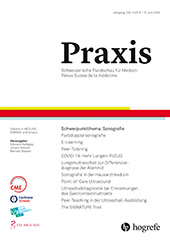Abstract
Zusammenfassung. Die Kontrastsonografie hat sich als zuverlässiges Hilfsmittel in der Diagnostik einiger Erkrankungen des Gastrointestinaltrakts bewährt. Bei Tumoren kann deren Ausdehnung abgeschätzt werden, und oft können entzündliche von neoplastischen Veränderungen abgegrenzt werden. Im oberen Gastrointestinaltrakt kann mittels oraler Kontrastierung die Magen- und Duodenalpassage sowie nach einer allfälligen Stenteinlage dessen Durchgängigkeit überprüft werden. Abszesse lassen sich mit CEUS gut darstellen, und nach Einlage einer Drainage kann deren Lage kontrolliert werden. Beim M. Crohn können Ausdehnung, Entzündungsintensität und Komplikationen wie Fisteln, Abszesse und Stenosen dargestellt werden. Die Abgrenzung entzündlicher von fibrotischen Stenosen erlaubt ein frühzeitiges Zuziehen eines Chirurgen. Eine ischämische Colitis zeigt im Akutstadium eine typische Anflutungskinetik, und im Verlauf kann mittels CEUS die verbesserte Perfusion dokumentiert werden.
Abstract. Contrast-enhanced ultrasound is a good diagnostic tool in certain gastrointestinal diseases. Inflammation of the gastric and the bowel wall can often be distinguished from neoplastic alterations. Gastric and duodenal stenosis can be depicted with the use of oral contrast, and after stenting the patency can be documented. Abscesses are perfectly delineated, and after drainage the exact location of the tube and possible complications can be documented. In patients with Crohn’s disease inflammatory activity and complications such as abscesses, fistulas and stenotic areas can be depicted. Distinction of fibrotic from inflammatory stenosis may help to look for surgical intervention in due time. Acute ischemic colitis has a typical perfusion pattern, and a control after a few days may show an increased vascularity.
Résumé. L’échographie de contraste offre des avantages pour le diagnostic des maladies gastro-intestinales. On peut souvent discriminer des modifications inflammatoires et des tumeurs malignes. Pour délimiter les sténoses gastriques et duodeniques on peut appliquer SonoVue par voie orale (une goutte sur 200 ml d’eau naturel) et après l’insertion d’un stent on peut contrôler la cohérence. Chez les patients avec la maladie de Crohn on peut obtenir des informations sur l’intensité inflammatoire et sur les complications comme les fistules, les abcès et les stenoses. Il est important de faire une distinction entre les stenoses inflammatoires et les stenoses fibrotiques afin de planifier une opération tôt. La colite ischémique se présente avec une cinétique d’inondation typique et au cours de la colite, la perfusion améliorée peut être documentée en utilisant CEUS.
Bibliografie
: Vascular pattern in ileal Crohn’s disease. Annals of Clinical Research 1975; 7: 23–31.
, : MR imaging evaluation of the activity of Crohn’s disease. AJR 2001; 177: 1325–1332.
, : Cross-sectional imaging in Crohn’s disease. RadioGraphics 2004; 24: 689–702.
: A Comparative radiographic and pathological study of intestinal vaso-architecture in Crohn’s disease and in ulcerative colitis. GUT 1970; 11: 928–940.
, : Quantitative measurement and visual assessment of ileal Crohn’s disease activity by computed tomography enterography: correlation with endoscopic severity and C-reactive protein. GUT 2006; 55: 1561–1567.
, : CT of prominent pericolic or perienteric vasculature in patients with Crohn’s disease: correlation with clinical disease activity and findings on barium studies. AJR 2002; 179: 1029–1036.
: The comb sign. Radiology 2004; 230: 783–784.
: MR Enteroclysis of inflammatory small-bowel diseases. AJR 2006; 187: 522–531.
: The EFSUMB Guidelines and Recommendations for the Clinical Practice of Contrast-Enhanced Ultrasound (CEUS) in Non-Hepatic Applications: Update 2017 (Long Version). Ultraschall in Med 2018: 39: e2–e44.



